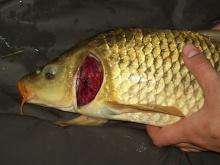January 18, 2010 report
Ion exchange may be most important driver of gill development in fish

(PhysOrg.com) -- A long-standing theory is that the first function of fish gills was to allow fish to breathe, but new research is casting doubt on the idea that this activity developed first.
A research team from the University of British Columbia in Canada studied the development of gills in the rainbow trout (Oncorhynchus mykiss) to find out which function of the gills appeared first: oxygen uptake or ion exchange. Their experiments suggest that gills were involved in ion exchange first, which further suggests this might have been the first activity to evolve. The experiments provide the first direct physiological evidence to support what is known as the ionoregulatory hypothesis.
The research team placed each larva in a type of compartmentalized plastic box called a flux chamber, which had one compartment for the head and gills, and another for the tail end, and then measured oxygen and ion levels (sodium and potassium) at both ends. By 15-16 days after hatching, the gills were exchanging more ions than the tail, but it took another 8-13 days before the gills were exchanging more oxygen. Ions (charged chemical particles) are necessary for the cells to function, but they can become toxic if their concentration in the blood is too high.
One of the researchers, Ms Clarice Fu, said that the pressures affecting larvae were similar to evolutionary pressures, which is why scientists often study the development of larvae to investigate evolution. She said that some of the pressures include an greater body size, more active lifestyle, and thicker skin. As the larvae grew the pressures (such as the thickening skin) drove ion exchange to the gills before they started to use the gills for breathing, which Fu said indicates the same thing may have occurred during the evolution of the fish: those individuals with gills capable of ion exchange would have a better chance of survival than those that did not, or those that retained a thinner skin for ion uptake.
The research paper is published online in this week's edition of the Royal Society journal Proceedings B.
More information: Ions first: Na+ uptake shifts from the skin to the gills before O2 uptake in developing rainbow trout, Oncorhynchus mykiss, Proceedings of the Royal Society B, doi:10.1098/rspb.2009.1545
© 2009 PhysOrg.com

















